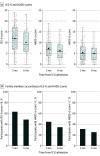Stress-Related Disorders of Family Members of Patients Admitted to the Intensive Care Unit With COVID-19
- PMID: 35467698
- PMCID: PMC9039825
- DOI: 10.1001/jamainternmed.2022.1118
Stress-Related Disorders of Family Members of Patients Admitted to the Intensive Care Unit With COVID-19
Abstract
Importance: The psychological symptoms associated with having a family member admitted to the intensive care unit (ICU) during the COVID-19 pandemic are not well defined.
Objective: To examine the prevalence of symptoms of stress-related disorders, primarily posttraumatic stress disorder (PTSD), in family members of patients admitted to the ICU with COVID-19 approximately 90 days after admission.
Design, setting, and participants: This prospective, multisite, mixed-methods observational cohort study assessed 330 family members of patients admitted to the ICU (except in New York City, which had a random sample of 25% of all admitted patients per month) between February 1 and July 31, 2020, at 8 academic-affiliated and 4 community-based hospitals in 5 US states.
Exposure: Having a family member in the ICU with COVID-19.
Main outcomes and measures: Symptoms of PTSD at 3 months, as defined by a score of 10 or higher on the Impact of Events Scale 6 (IES-6).
Results: A total of 330 participants (mean [SD] age, 51.2 [15.1] years; 228 [69.1%] women; 150 [52.8%] White; 92 [29.8%] Hispanic) were surveyed at the 3-month time point. Most individuals were the patients' child (129 [40.6%]) or spouse or partner (81 [25.5%]). The mean (SD) IES-6 score at 3 months was 11.9 (6.1), with 201 of 316 respondents (63.6%) having scores of 10 or higher, indicating significant symptoms of PTSD. Female participants had an adjusted mean IES-6 score of 2.6 points higher (95% CI, 1.4-3.8; P < .001) than male participants, whereas Hispanic participants scored a mean of 2.7 points higher compared with non-Hispanic participants (95% CI, 1.0-4.3; P = .002). Those with graduate school experience had an adjusted mean score of 3.3 points lower (95% CI, 1.5-5.1; P < .001) compared with those with up to a high school degree or equivalent. Qualitative analyses found no substantive differences in the emotional or communication-related experiences between those with high vs low PTSD scores, but those with higher scores exhibited more distrust of practitioners.
Conclusions and relevance: In this cohort study, symptoms of PTSD among family members of ICU patients with COVID-19 were high. Hispanic ethnicity and female gender were associated with higher symptoms. Those with higher scores reported more distrust of practitioners.
Conflict of interest statement
Figures


References
Publication types
MeSH terms
LinkOut - more resources
Full Text Sources
Medical

